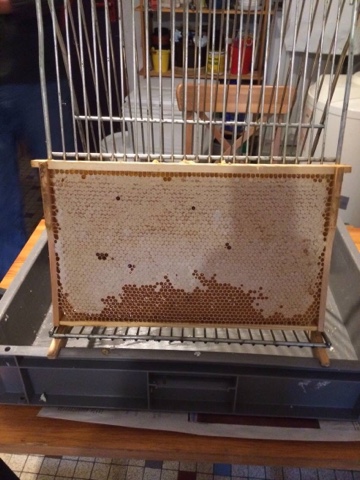I meant to post a picture of my wasp trap the other day. Here it is:
I used a variety of liquid bait, but what has worked best is Mountain Dew (jacked up with added sugar) and apple juice/vinegar. The trap in the photo above is a jar with a small hole in the lid. I smeared the underside of the lid with jam. It has been very effective. I also used empty plastic bottles with the top cut off and inverted. These work, but not as well.
Also effective is the bees themselves. Since I had to take the entrance reducer out (see Formic acid discussion below), the wasps were really crowding the door. The bees were being aggressive and defending the hive by knocking the wasps away. To help them a bit, I stuffed some grass in the opening. Seemed like a reasonable compromise.
The bit of pink on the bottom of the hive in the picture above is sidewalk chalk. It is supposed to keep ants out, and seems to work. I just drew loopy doodles around the lowest brood box.
I have had a visitor to the hives as evidenced by the picture below.
I have found two such … piles. Fox, perhaps? I don't know.
Yesterday I broke down and installed Formic acid dispensers in each hive (to treat varroa). In case you are interested, I'm using 85%. I was worried about how the bees would react to the acid. I didn't have any problem handling it-- although I wore dishwashing gloves and my glasses and brought a bucket of water with me -- but the smell is apparently quite strong, and the bees don't like it. Now I'm worried that it won't be strong enough to do the job, but everything I've read says "READ AND FOLLOW THE INSTRUCTIONS!" So no going off piste here. That said, it looks like business as usual for the bees. No piles of sad bee corpses anyhow. At least not yet.
I was told to open the hive door, but to install the tray that goes under the hive (which blocks much of the ventilation that comes from underneath). I was afraid this would be a problem, but seems okay.
I'm reading more and more online about the benefits of not using foundation, particularly in terms of varroa treatment. Left to their own devices, the bees make smaller cells, and the mites prefer larger cells. As I replace frames, I'm going foundationless (with a Toblerone-shaped strip of wood trim at the top of the frame as a starter).
Lots and lots of pollen going into the hive the past few days (well, perhaps longer, but I've been paying attention this week). I don't know exactly what it is, although pollen.lu says that chestnut and nettle is heavy this week. Not sure what color nettle pollen is. The picture above doesn't really show it, but there were as many as four or five bees with full pollen trousers in the hive entrance.














